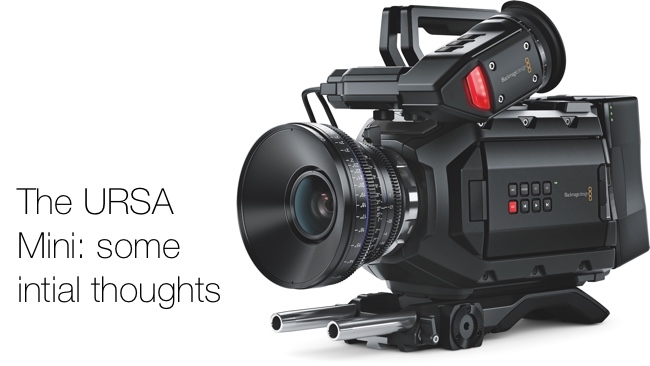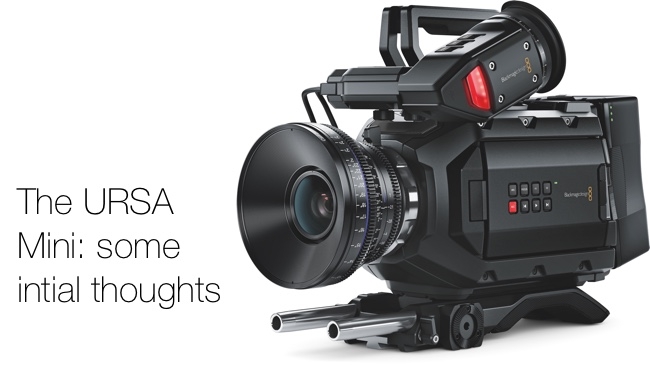
 Show stealer: the URSA Mini
Show stealer: the URSA Mini
Written while still in Vegas, Red Shark technical editor, Phil Rhodes, offers his initial reactions to the URSA Mini.
With ever-nicer pictures coming out of packages that keep getting smaller as they get cheaper, complaints that modern cameras feel impossibly flimsy and lightweight are no news. These developments have of course made a lot of previously impractical things practical – producers of mountaineering documentaries, for instance, presumably breathe a small sigh of relief every time the ounces-to-pixels ratio of cameras in general alters slightly in their favour. But the main complaint, perhaps from people used to full-size cameras from that awkward crossover period where cameras and recorders could be docked together in various solid and weighty combinations, was that the small, light stuff lacked sufficient inertia for comfortable handheld shooting.
Then, Blackmagic released the URSA, and more or less everyone, including your curmudgeonly narrator, said “Er, well, okay, but hang on a minute.” The solidity of build and shoulder-mounted balancing were very, very welcome, and commentators went out of their way to praise them, but there’s no escaping the fact that URSA is big and heavy, in much the same way that we were a little cautious about the bulk of Arri’s Amira given its stated purpose. So universal was this view that it’s really no surprise to find a smaller version – URSA Minor, as quipped by more or less everyone in the hemisphere by half past nine this morning – announced at NAB.
The camera (or rather cameras, as there are options) are likely to be covered more than adequately elsewhere, however, so we’ll concentrate here on two things which are being obscured somewhat by the furore over the fact that the thing exists at all. The first is that Blackmagic has gone out of house for a custom sensor. This is not unusual, inasmuch as the only camera manufacturers which actually own semiconductor fabrication facilities are Sony and Canon, but it’s probably the first time that Blackmagic has commissioned custom silicon from anyone.
The claim is 4.6K of (Bayer) resolution, and fifteen stops of dynamic range, and a global shutter up to a certain frame rate. Even allowing for the usual degree of corporate hyperbole, this answers several concerns about previous devices: the 2.5K Cinema Camera is excellent but suffers rolling shutter, and the 4K Production Camera has a global shutter and the high resolution but lacks the superb dynamic range of its lower resolution cousin. Both lack high frame rate options, but the new sensor is a potential answer to this desire to have all things, all ways. Some form of reasonably objective test is of course required and there is no word yet of the intended output colorimetry, although clearly any log encoding or colourspace offered by a Blackmagic camera is likely to make its way quickly into Resolve at the very least.
The other, perhaps even less-noted release that’s associated with the new camera is its viewfinder, or lack thereof. URSA was released without a viewfinder, which frankly just made it seem even more expensive by the time a third-party device was factored in. Blackmagic’s viewfinder is of broadly comparable price to other options but may actually be the first full-resolution, simultaneous-colour example of such a device. Questions about using the Blackmagic viewfinder on non-Blackmagic cameras were at first met with quizzical stares, but after a brief discussion between engineers here at the show, it was eventually concluded that – yes, it’s a standard 3Gbps SDI device which will handle at least anything up to 30fps given 12V power. Users intending to apply a Blackmagic viewfinder to third-party cameras would probably be well-advised to try a demo unit first, as there are many sub-format options and complexities to work out (segmented frame, and so on) and there is the question of mounting. Even so, this is a major advance in viewfinders at almost any level.
I would probably have preferred to see something other than CFast chosen as a recording medium as it’s still expensive, and I would have liked to have seen an option for a micro-four-thirds mount, as the range of adaptors is extensive. It would have been nice, for instance, to have the option to use B4 broadcast zooms – with an appropriate optical adaptor such as that from MTF Services – to build a neat, tidy and affordable ENG outfit around an URSA Mini. The only currently available options involve things like the huge, and hugely expensive, Fujinon Cabrio 19-90 and others of its ilk, which are not financially a realistic match for URSA.
The cost of an URSA Mini, with the new sensor and with the viewfinder, top handle, sliding shoulder mount and other accessories, is likely to approach that of an FS7, although the FS7 would not be able to record either raw or ProRes, both of which the URSA Mini will do out of the box, without its expensive tail-end add-on. Even so, this is dangerous territory: the FS7 is a good solid camera with a sensor that fills the logarithmic bit bucket with some avidity. At first glance (and we have had nothing much more than that) the URSA looks to have a better ergonomic layout, without Sony’s smothering of buttons and switches. Comparisons to higher-end cameras of much higher cost are dicier, but it’s presumably a very up-to-date sensor design and we look forward to putting some test charts in front of it.
Tags: Production


Comments